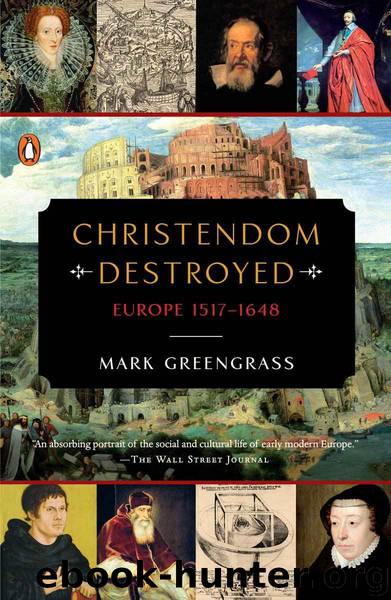Christendom Destroyed: Europe 1517-1648 (The Penguin History of Europe) by Mark Greengrass

Author:Mark Greengrass [Greengrass, Mark]
Language: eng
Format: azw3
Publisher: Penguin Publishing Group
Published: 2014-11-28T05:00:00+00:00
JEAN CALVIN AND GENEVA
Calvin was in voluntary exile. Basel offered safety but not security. Fortunately for him, his cousin Pierre-Robert Olivétan lived there. Evangelically inclined like Calvin, he was completing his French translation of the Bible, to which Calvin provided prefaces. That addressed to ‘Those who love Jesus Christ and his Gospel’ was an evocation of all that God had created. Published in Neuchâtel, Olivétan’s Bible (paid for by the Waldensians) was a remarkable achievement. Calvin later altered it, but he did not change the way in which Olivétan chose, wherever possible, to render the Hebrew in terms that had no trace of the old religion. ‘Bishop’ became ‘surveillant’; ‘priest’, ‘pasteur’; ‘chalice’, ‘cup’; ‘church’, ‘temple’, etc. The glossary of French Protestantism was under construction.
Some of Basel’s printers were committed to the evangelical cause. In March 1536, two of them published the first Latin edition of a book that (in a very different form) would become indissociable from the name of Calvin. It was initially entitled Of the Christian Religion, the Institution. Calvin had perhaps travelled with a draft of the text on paper or in his head. In form, it was a manual of Protestant orthodoxy. But it was also intended as an apology for the French ‘evangelicals’ facing post-Placard repression. In a preface addressed to Francis I, Calvin countered the suggestion that they were the sixteenth-century equivalent of terrorists. The Institution of the title implied ‘manual’, but it also meant ‘foundation’. Protestants, Calvin told the king, supported the pillars of the Christian faith. They were not the cause of trouble; that was the fault of others. He quoted 1 Kings 18: ‘it is not we who spread errors abroad or incite tumults; it is they who contend against God’s power’.
The work opened with a sentence whose formula came from Cicero: ‘Almost all sacred doctrine consists of two parts: knowledge of God, and of ourselves.’ That combined knowledge was ‘nothing else than a firm conviction of mind whereby we determine with ourselves that God’s truth is so certain, that it is incapable of not accomplishing what it has pledged to do by his holy Word’. Calvin was paraphrasing a passage from Paul’s Epistle to the Romans (10:11), which would be the work on which he published his first Bible commentary four years later in March 1540. By then, he had thoroughly revised the Institution. Publishing this second edition (renamed the Institution of the Christian Religion) in 1539, he now envisaged it as complementing his biblical commentaries. The work was intended ‘to prepare and instruct candidates in sacred theology in the reading of the divine Word’, and to contain the ‘sum of religion in all its parts’ so that, when it came to expositions of the Scriptures, he would be able to ‘condense them’ since he had already laid out the underlying fabric. Thereafter, through to the final Latin edition of the Institutes (as they are known) in Calvin’s lifetime (1559), its text grew, taking into account the weight of his learning and the need to complement his Bible commentaries as they appeared.
Download
This site does not store any files on its server. We only index and link to content provided by other sites. Please contact the content providers to delete copyright contents if any and email us, we'll remove relevant links or contents immediately.
The Gnostic Gospels by Pagels Elaine(2400)
Jesus by Paul Johnson(2230)
Devil, The by Almond Philip C(2207)
The Nativity by Geza Vermes(2117)
The Psychedelic Gospels: The Secret History of Hallucinogens in Christianity by Jerry B. Brown(2075)
Forensics by Val McDermid(1980)
Going Clear: Scientology, Hollywood, and the Prison of Belief by Lawrence Wright(1885)
Going Clear by Lawrence Wright(1873)
Barking to the Choir by Gregory Boyle(1732)
Old Testament History by John H. Sailhamer(1715)
Augustine: Conversions to Confessions by Robin Lane Fox(1688)
The Early Centuries - Byzantium 01 by John Julius Norwich(1655)
A History of the Franks by Gregory of Tours(1640)
The Bible Doesn't Say That by Dr. Joel M. Hoffman(1611)
Dark Mysteries of the Vatican by H. Paul Jeffers(1607)
A Prophet with Honor by William C. Martin(1603)
by Christianity & Islam(1564)
The First Crusade by Thomas Asbridge(1539)
The Amish by Steven M. Nolt(1492)
